Safe circuit design
As we saw earlier, a power system with no
secure connection to earth ground is unpredictable from a
safety perspective: there's no way to guarantee how much or
how little voltage will exist between any point in the
circuit and earth ground. By grounding one side of the power
system's voltage source, at least one point in the circuit
can be assured to be electrically common with the earth and
therefore present no shock hazard. In a simple two-wire
electrical power system, the conductor connected to ground
is called the neutral, and the other conductor is
called the hot:
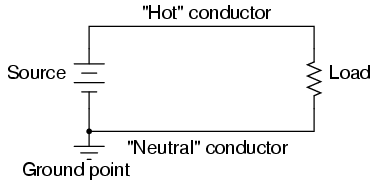
As far as the voltage source and load are
concerned, grounding makes no difference at all. It exists
purely for the sake of personnel safety, by guaranteeing
that at least one point in the circuit will be safe to touch
(zero voltage to ground). The "Hot" side of the circuit,
named for its potential for shock hazard, will be dangerous
to touch unless voltage is secured by proper disconnection
from the source (ideally, using a systematic
lock-out/tag-out procedure).
This imbalance of hazard between the two
conductors in a simple power circuit is important to
understand. The following series of illustrations are based
on common household wiring systems (using DC voltage sources
rather than AC for simplicity).
If we take a look at a simple, household
electrical appliance such as a toaster with a conductive
metal case, we can see that there should be no shock hazard
when it is operating properly. The wires conducting power to
the toaster's heating element are insulated from touching
the metal case (and each other) by rubber or plastic.

However, if one of the wires inside the
toaster were to accidently come in contact with the metal
case, the case will be made electrically common to the wire,
and touching the case will be just as hazardous as touching
the wire bare. Whether or not this presents a shock hazard
depends on which wire accidentally touches:

If the "hot" wire contacts the case, it
places the user of the toaster in danger. On the other hand,
if the neutral wire contacts the case, there is no danger of
shock:

To help ensure that the former failure is
less likely than the latter, engineers try to design
appliances in such a way as to minimize hot conductor
contact with the case. Ideally, of course, you don't want
either wire accidently coming in contact with the conductive
case of the appliance, but there are usually ways to design
the layout of the parts to make accidental contact less
likely for one wire than for the other. However, this
preventative measure is effective only if power plug
polarity can be guaranteed. If the plug can be reversed,
then the conductor more likely to contact the case might
very well be the "hot" one:
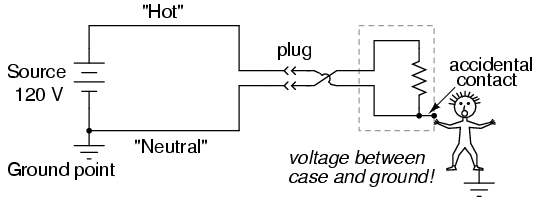
Appliances designed this way usually come
with "polarized" plugs, one prong of the plug being slightly
narrower than the other. Power receptacles are also designed
like this, one slot being narrower than the other.
Consequently, the plug cannot be inserted "backwards," and
conductor identity inside the appliance can be guaranteed.
Remember that this has no effect whatsoever on the basic
function of the appliance: it's strictly for the sake of
user safety.
Some engineers address the safety issue
simply by making the outside case of the appliance
nonconductive. Such appliances are called
double-insulated, since the insulating case serves as a
second layer of insulation above and beyond that of the
conductors themselves. If a wire inside the appliance
accidently comes in contact with the case, there is no
danger presented to the user of the appliance.
Other engineers tackle the problem of safety
by maintaining a conductive case, but using a third
conductor to firmly connect that case to ground:

The third prong on the power cord provides a
direct electrical connection from the appliance case to
earth ground, making the two points electrically common with
each other. If they're electrically common, then there
cannot be any voltage dropped between them. At least, that's
how it is supposed to work. If the hot conductor accidently
touches the metal appliance case, it will create a direct
short-circuit back to the voltage source through the ground
wire, tripping any overcurrent protection devices. The user
of the appliance will remain safe.
This is why it's so important never to cut
the third prong off a power plug when trying to fit it into
a two-prong receptacle. If this is done, there will be no
grounding of the appliance case to keep the user(s) safe.
The appliance will still function properly, but if there is
an internal fault bringing the hot wire in contact with the
case, the results can be deadly. If a two-prong receptacle
must be used, a two- to three-prong receptacle
adapter can be installed with a grounding wire attached to
the receptacle's grounded cover screw. This will maintain
the safety of the grounded appliance while plugged in to
this type of receptacle.
Electrically safe engineering doesn't
necessarily end at the load, however. A final safeguard
against electrical shock can be arranged on the power supply
side of the circuit rather than the appliance itself. This
safeguard is called ground-fault detection, and it
works like this:
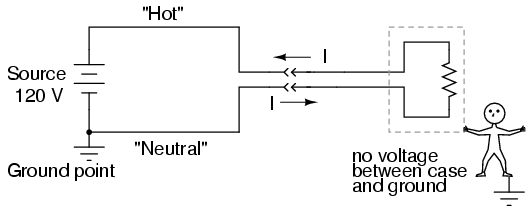
In a properly functioning appliance (shown
above), the current measured through the hot conductor
should be exactly equal to the current through the neutral
conductor, because there's only one path for electrons to
flow in the circuit. With no fault inside the appliance,
there is no connection between circuit conductors and the
person touching the case, and therefore no shock.
If, however, the hot wire accidently
contacts the metal case, there will be current through the
person touching the case. The presence of a shock current
will be manifested as a difference of current between
the two power conductors at the receptacle:
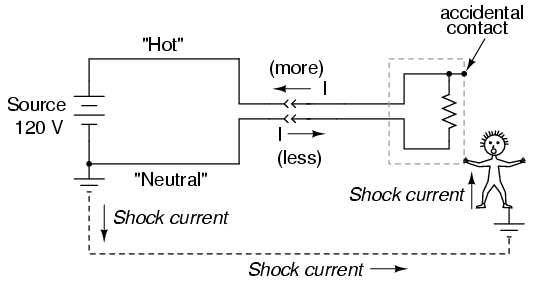
This difference in current between the "hot"
and "neutral" conductors will only exist if there is current
through the ground connection, meaning that there is a fault
in the system. Therefore, such a current difference can be
used as a way to detect a fault condition. If a
device is set up to measure this difference of current
between the two power conductors, a detection of current
imbalance can be used to trigger the opening of a disconnect
switch, thus cutting power off and preventing serious shock:
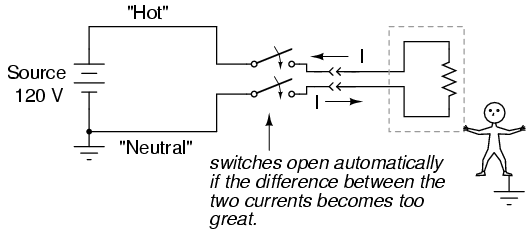
Such devices are called Ground Fault
Current Interruptors, or GFCIs for short, and they are
compact enough to be built into a power receptacle. These
receptacles are easily identified by their distinctive
"Test" and "Reset" buttons. The big advantage with using
this approach to ensure safety is that it works regardless
of the appliance's design. Of course, using a
double-insulated or grounded appliance in addition to a GFCI
receptacle would be better yet, but it's comforting to know
that something can be done to improve safety above and
beyond the design and condition of the appliance.
-
REVIEW:
-
Power systems often have one side of the
voltage supply connected to earth ground to ensure safety
at that point.
-
The "grounded" conductor in a power system
is called the neutral conductor, while the
ungrounded conductor is called the hot.
-
Grounding in power systems exists for the
sake of personnel safety, not the operation of the load(s).
-
Electrical safety of an appliance or other
load can be improved by good engineering: polarized plugs,
double insulation, and three-prong "grounding" plugs are
all ways that safety can be maximized on the load side.
-
Ground Fault Current Interruptors (GFCIs)
work by sensing a difference in current between the two
conductors supplying power to the load. There should be no
difference in current at all. Any difference means that
current must be entering or exiting the load by some means
other than the two main conductors, which is not good. A
significant current difference will automatically open a
disconnecting switch mechanism, cutting power off
completely.
|